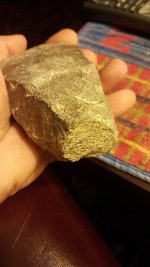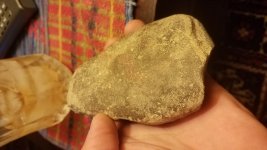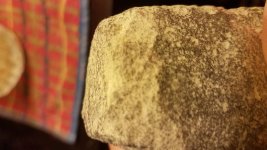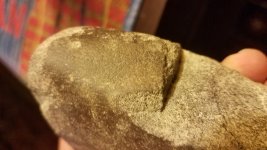Navigation
Install the app
How to install the app on iOS
Follow along with the video below to see how to install our site as a web app on your home screen.
Note: This feature may not be available in some browsers.
More options
You are using an out of date browser. It may not display this or other websites correctly.
You should upgrade or use an alternative browser.
You should upgrade or use an alternative browser.
New here! So forgive if I have a geofact!
- Thread starter Nedhawks
- Start date
Older The Better
Silver Member
- Apr 24, 2017
- 3,399
- 6,697
- Detector(s) used
- Whites Eagle Spectrum
- Primary Interest:
- All Treasure Hunting
Is it sandstone or a quartzite?
Tdog
Silver Member
I don't think it's a hammer stone nor axe because of it's shape, material and size.
Huzzah!
Sr. Member
I don’t think it is an artifact Ned.
I collect almost exclusively from the James river basin, so I’m nearby. I’ve seen a wide variety of stones from our area and this stone doesn’t appear to me tampered with by man—JMO. I can’t hold it myself, but from the photos provided there isn’t enough variation across the surface of the stone to indicate one area has been the focus of use compared to other areas. How it fits in my hand is something I don’t consider—if there are legit signs of wear I don’t care how it fits in my hand; the proof is otherwise obvious.
Save this piece for education. When you find a hammerstone its details will stick out—as I found with the picture below. I didn’t know why this rock looked so strange to me, but once I posted it the obvious became obvious to me and I’m glad I picked it up. I’ve never seen a natural stone whose edges are so definitively pecked in contrast to the faces of the stone. That ain’t natural.
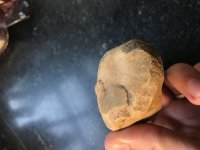
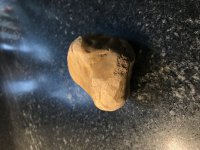
I collect almost exclusively from the James river basin, so I’m nearby. I’ve seen a wide variety of stones from our area and this stone doesn’t appear to me tampered with by man—JMO. I can’t hold it myself, but from the photos provided there isn’t enough variation across the surface of the stone to indicate one area has been the focus of use compared to other areas. How it fits in my hand is something I don’t consider—if there are legit signs of wear I don’t care how it fits in my hand; the proof is otherwise obvious.
Save this piece for education. When you find a hammerstone its details will stick out—as I found with the picture below. I didn’t know why this rock looked so strange to me, but once I posted it the obvious became obvious to me and I’m glad I picked it up. I’ve never seen a natural stone whose edges are so definitively pecked in contrast to the faces of the stone. That ain’t natural.


Zippidy~Do~Daa
Jr. Member
I may be way off here, but that looks like petrified bone to me.
Quartzite Keith
Full Member
- Dec 17, 2018
- 179
- 406
- Primary Interest:
- All Treasure Hunting
Well, you know how it goes, hard to say without having them in hand. Looks like quartzite, which being very dense, has that "heavy" feel you describe. On both, the ends look battered in an unnatural way and both look to be about the right size to be good for crushing up seeds or shelling acorns and hickory nuts, so I think it's possible you have something there. Not flint knapping hammer stones, though. I busted up a bunch of hickory nuts once to make hickory nut soup and I used a piece of quartzite like that.
Top Member Reactions
-
 3440
3440 -
 2012
2012 -
 1949
1949 -
 1156
1156 -
 1101
1101 -
 909
909 -
 807
807 -
 801
801 -
 798
798 -
 788
788 -
 746
746 -
 532
532 -
 477
477 -
 475
475 -
 445
445 -
 422
422 -
 416
416 -
 416
416 -
E
415
-
 390
390
Users who are viewing this thread
Total: 2 (members: 0, guests: 2)
